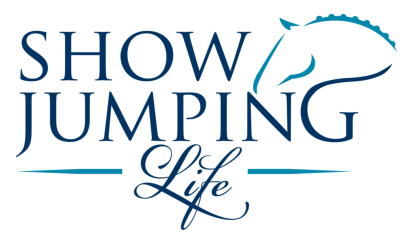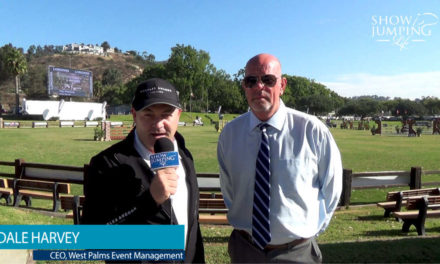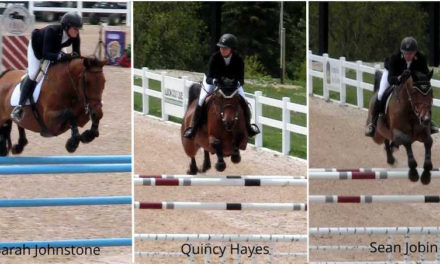From Ponies To The Grand Prix Ring And Beyond: Part 1
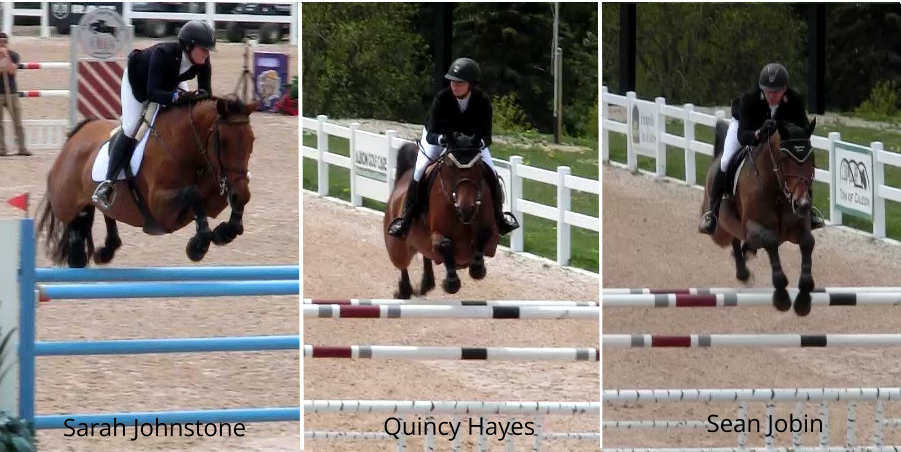
An Interview Series Examining The Rise Of Three Young Canadian Show Jumping Professionals
Part 1: The path to professionalism
Have you ever wondered what it’s like to be a young professional trying to make your way in this sport? Me too! In this three-part series, I sit down with three successful young Canadian show jumping professionals to learn how they went from the pony ring to growing their current businesses and competing in FEI ranking classes. In these articles, the riders and I discuss:
- Their background and path to becoming a professional;
- Their thoughts on training and coaching, and;
- Their personal riding careers and goals.
I interview Sarah Johnstone, Quincy Hayes and Sean Jobin, all of whom have had their share of success in the jumper and hunter rings as both juniors and now professional riders. Despite the different routes they have taken, they currently are all successful and respected trainers, riders, and horse people.
About the riders:
Quincy Hayes with her mom, Darcy

Photo courtesy Jump Media
Quincy Hayes first began her competitive career at the age of 5 and has been achieving top results in the jumper, hunter and equitation rings ever since. During her junior years, Quincy was a fierce competitor in the equitation ring in the United States and Canada, winning the CET Medal and Jump Canada Medal finals. Following her junior career, Quincy was awarded an athletic scholarship from Auburn University to compete for their varsity equestrian team and was a member of the 2011 and 2014 NCAA Championship winning teams. In the summer of 2015, Quincy acquired her first Grand Prix horse (Calgary 56) and in just two short months of showing, qualified for the National Talent Squad finals, finishing 6th overall. The following year Quincy was on the same 2nd placed Canadian team as Sarah in Wellington, FL for the U25 team competition. In 2016, Quincy burst onto the FEI scene with many top results, finishing her season with a strong performance in Toronto, posting two solid rounds in the Canadian Championships and a 2nd place finish in the U25 Championship (the top placed Canadian).
She is now Co-Trainer at Hayes LTD, alongside her mother Darcy, in Aurora, Ontario. At Hayes LTD she teaches students from the pony ring up to the high Jr/Am jumper classes.
Sean Jobin
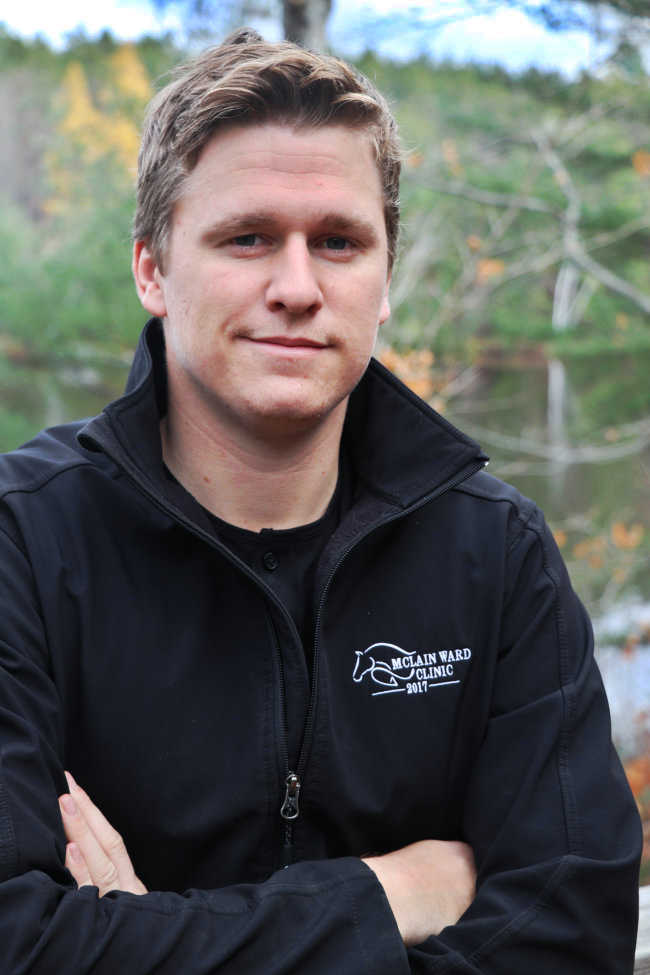
Sean Jobin had great visibility as a junior rider, showing many different horses in the hunter and jumper rings. Following a productive junior career, Sean turned professional at 18, immediately getting hired as a rider by trainers in Canada to showcase their sales and young horses. During this time, he picked up a number of Modified Grand Prix and Talent Squad wins. These results were even more impressive given that they came on sale horses that Sean had the ride on for only a short period of time.
Sean continues to focus on developing horses for the jumper and hunter rings through his business in Canada, while also competing at the Grand Prix level for Foxridge Farms.
Sarah Johnstone (left) with Olympic Show Jumper, Beth Underhill
Sarah Johnstone has been relied upon since she was 8 years old to showcase hunters and jumpers by top industry professionals. As a junior rider, she was the youngest person, at 15 years old, to win both the Canadian Equestrian Team (CET) and Jump Canada Medal finals in the same year. In 2010 during her first year as a professional, after a successful summer winning many grand prix titles, Sarah was 3rd at the Canadian Championships. Recognizing her passion and achievements, in 2011 the North American Riders Group (NARG) chose Sarah, then just 20 years old, to receive its inaugural $15,000 grant awarded to an emerging rider dedicated to the sport of show jumping. In 2016, Sarah finished 7th overall in the Under 25 (U25) rider series in Wellington, Florida; and was a member of the 2nd place Canadian team in the U25 series.
She is currently head trainer at Wingberry Farm in Nobleton, Ontario.
I met up with these three young professionals at the Caledon Equestrian Park to discuss their past, current thoughts on their careers and plans for the future. The first article, presented below, covers their background and path to becoming professionals.
Rosalie: First, I want to thank you all for agreeing to sit down for this interview. To begin, briefly outline your route into coaching/riding and your mentors.
Sarah: I started with Penny Murray. She is an incredibly hard working person and the best coach you could find to instill the correct foundation in a young rider. She became a close family friend and when the time came for me to continue my development as a rider, she was supportive in directing me towards another trainer so that I could continue to learn. Penny introduced me to Canadian Olympian Jay Hayes and his daughter Lauren Hayes and that is how I came to start training with them. I rode with them for many years and I will be forever grateful for the countless invaluable opportunities and experiences they gave me. I then spent a year in The Netherlands to expand my knowledge, riding for Stal Hendrix under the tutelage of Paul Hendrix. This helped me get more time in the show ring and learn a lot about the business side of this industry. When I came back, I started working full time with Canadian Olympian Beth Underhill. Beth played an important role in my development as a rider and trainer and I am still very close to her. Eventually, I became the head trainer at Wingberry Farm, my current position, where I have many clients, as well as my own string of horses that I am bringing along.
Quincy: In my junior years, I was a working student for renowned trainers such as Chris Sorensen (Sorensen Stables), Dave Belford and Chris Payne (New Hope Farm) and Andre Dignelli and Patricia Griffith (Heritage Farms). Looking back, working alongside these accomplished horsemen is probably what gave me the knowledge and confidence that I needed to begin coaching. I was also awarded a scholarship by Auburn University to ride for their varsity equestrian team during the school years from 2010-2014. Over the summers I would travel to Europe and ride with Robert Vos who is located in the Netherlands. As soon as I graduated from university, I turned professional and had the opportunity to spend a year in Europe, this time as a hired rider working for Robert Vos. Following my time in Europe, I returned to Canada and was immediately hired by Chris Sorensen as an assistant trainer for Sorensen Stables. In this role, I helped with the managing, teaching and showing aspects of the business. Not too long after, I got the chance to partner up with the then 9-year old Calgary 56. I owe a lot to Chris and Robert (Vos) for finding this horse and believing that our partnership could be successful at the FEI level. Later, when Chris (Sorensen) dissolved his business in North America to focus on his career in Europe, we (myself in partnership with my mom, Darcy) took it on.
Sean: Mike Grinyer and Hugh Graham were very important in the development of my career. They taught me a lot in terms of riding, buying and selling horses, and running a business. Mike gave me great opportunities by providing me with a lot of sales horses to show. Riding with Hugh was also very rewarding because I got the opportunity to show and develop a lot of his young horses. All this time spent in the show ring is probably what got me the exposure and the experience that allowed me to get my sponsorship and to start a sales business.
Rosalie: Sarah, you mentioned going to Europe to ride for Stal Hendrix. Can you explain a bit more about that decision and what you learned from it?
Sarah: I decided to go to Europe because I wanted to gain more knowledge. The Europeans have always been very successful at producing horses and winning major championships. I wanted to see how they do things differently and learn from it as much as I could. I thought it would add to my education, making me a well-rounded trainer and rider. Looking back on it, I can now say that it helped a lot to further my knowledge of the industry and to broaden my network.
Rosalie: Now Quincy, you had a bit of a different route. You went to school at Auburn University and would go to Europe in the summers to train. What did those experiences teach you?
Quincy: The team spirit at Auburn was unlike anything I had experienced before. It taught me how to deal with the pressure that comes from riding for a team. The demanding schedule also helped me develop time-management skills. Riding on a varsity team is not for the faint-hearted: you need to be determined, hard-working and organized in order to make it happen. All essential qualities needed to run a successful business. You also have to work out everyday! My trainer would say, “When talent evens out, physical fitness makes the difference”. Being physically fit definitely made me a stronger and better rider and I have continued to incorporate those factors into my riding. On the other hand, the time I spent in Europe was a completely different learning experience because I was able to focus solely on my riding skills. Riding at least 12 horses a day, from 3-year-old stallions to grand-prix level horses, certainly helped me become the rider that I am today.
Rosalie: Sean, you stayed in North America to learn and develop as a rider, working a lot with young horses. Can you describe how all of those young horse experiences have helped shape your career today?
Sean: I think every young professional wants to go to Europe to ride but it simply never materialized for me. I always had a good string of horses to show in North America, so going to Europe would have meant I would lose those rides while I was away, which was never feasible for my business. However, I do not regret my choices: by riding so many young horses here, I learned to create riding programs that were suitable for each of them and it has helped me greatly now that I have my own business. Not every horse you sit on will make it to the grand prix level but you still need to optimize a training program that will ensure they are developed to their full potential.
Rosalie: Sarah, you are currently the head trainer at Wingberry Farm in Nobleton, Ontario. Can you speak to your current goals and what you are focusing on at Wingberry?
Sarah: At Wingberry Farm, I work towards developing my students into accomplished, confident and successful riders as well as developing young and sales horses according to their potential. I am also always focused on developing and promoting my career as a rider, with the goal of finding horses that will allow me to compete successfully in Grand Prix classes.
Rosalie: Quincy, you have partnered with your mother, Darcy, to operate Hayes LTD located in Aurora, Ontario. You have a large number of clients and they are stabled at two different locations when you aren’t all together at shows. What are some of the challenges of operating on a large scale and how do you manage this situation?
Quincy: The success of our operation relies on time management, organization, communication and prioritization. Also, Hayes LTD would not be possible without the incredible team that we have around us. Between our vets, farriers, chiropractors, managers and grooms, no stone goes unturned. I think the key is to make sure that you are always surrounded with a reliable team.
Rosalie: Now Sean, your career is a bit different from that of Quincy and Sarah, as you don’t have many students, instead focusing predominantly on buying and selling. Was this always your goal, or did the situation simply develop as you were beginning your professional career?
Sean: In my case, my sponsorship took the form of a sales-oriented operation. I do not turn my back on teaching students but it just is not path that I am currently on. I am really enjoying finding and developing different types of horses, as well as the challenge that comes with matching the right owners for all of the horses when the time comes to sell them.
Rosalie: Alright, I will bring this discussion back together for you all now. Was there a particular moment in your career as a rider where you felt ready to go from junior/amateur to professional status? Was the transition difficult?
Sarah: Turning professional was always very clear for me because I wanted to work with and show horses but did not own any personally. Thus, the only option I had was to make a living in this sport. My trainer at the time, Jay Hayes, made the transition flow nicely by giving me a lot of opportunities to make my name as a young professional.
Quincy: For me, I always knew I wanted to make a living out of riding and training horses. At the same time, it was important for me to explore other career options so that I could be 100% confident in my choice to turn professional and not wonder ‘what if?’ down the road. During university, I spent a summer interning for Under Armour Canada and although it was a great experience, it solidified my choice to turn professional and make equestrian sport my career. Also, the fact that I had already talked with Chris Sorensen about working for him after graduating from university, helped my transition go smoothly.
Sean: I never really thought about the decision to turn professional! I was spending all my time in the saddle, so in my mind when I turned 18 years old, there was no other option than to make it a profession. My trainer at the time, Mike Grinyer, guided me through the process and although it has not always been easy, now that I look back on it, it was well worth it.
Up Next: Part 2 – Training Philosophy
